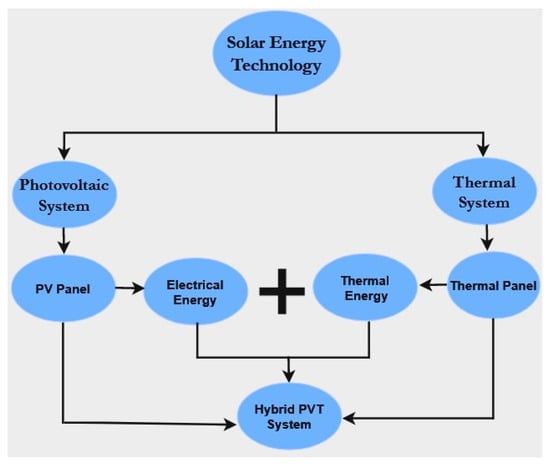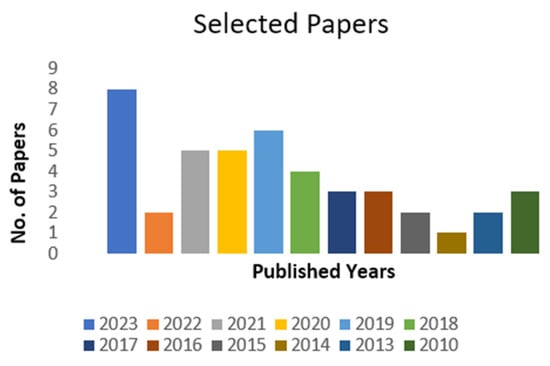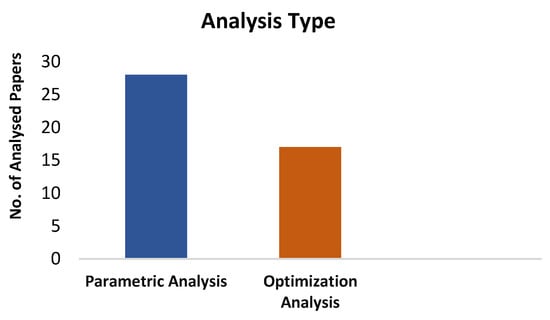A crucial fact today is that the whole world is gripped by the concern of dwindling energy stocks, leading to efforts to conserve fossil fuels through the exploration of new methods and resources. The drive for conservation is not solely due to the rapid depletion of resources but also stems from the harmful impact of certain resources on the ecosystem. In addition to these factors, the prices of fossil fuels exhibit high volatility, often experiencing significant inflation [
1]. Many human activities driven by energy consumption and resulting pollution have contributed to swift alterations in weather conditions, including global warming, the thawing of polar ice caps, and the depletion of the ozone layer. In the future, the issues of environmental pollution and global warming could be mitigated by the adoption of renewable energy sources like solar power, particularly those using photovoltaic (PV) technology. Solar PV technology is utilized for the conversion of light energy into DC energy for electricity. The fundamental unit of PV technology is the solar cell, which can be arranged in series and parallel connections to create a PV module. Multiple PV modules can also be linked in series and parallel configurations to form larger PV arrays [
2].
PV power plant shares have surged globally, with numerous countries now aiming to extend the utilization of alternative energy sources for generating electricity. The European Union has committed to creating a blueprint that raises the contribution of renewable energy sources in energy production to no less than 30% by 2030, with the final goal of achieving 100% by 2050 [
3]. The economic and environmental advantages of PV technology have made it a highly sought-after solution for clean power generation, drawing immense interest from researchers, manufacturers, and decision-makers alike [
4]. Numerous regions across the globe possess the potential to implement high-efficiency PV plants, owing to the high intensity of solar radiation in these areas. The high degree of flexibility exhibited by PV technology sets it apart from other solar applications, as it can be deployed in diverse geographical locations, ranging from deserts and plains to mountains and even marine environments. This adaptability allows it to function independently or connected to an electrical grid, thereby expediting its widespread global adoption, particularly following the decrease in manufacturing costs and the rise in electrical efficiency [
5]. PV technology is increasingly favored due to its numerous promising benefits, including minimal maintenance requirements, low operating costs, a long lifespan, and a significant reduction in CO
2 emissions, thereby promoting a cleaner environment for future generations.
2. Hybrid PVT System and Classifications
The utilization of solar power in renewable energy systems can be employed to produce electrical and thermal energy using solar PV panels and thermal panels [
28,
29]. In general, solar photovoltaic technology collects solar radiation and converts it into electrical energy [
30,
31]. On the other hand, irradiance is captured by the solar collector and converted to heat that can be used for a variety of purposes. In the middle of the 1970s, after various studies, the PVT system was discovered [
32]. A liquid-type of solar collector of hybrid PVT was investigated in 1976 by observing the performance of the collector in a single-family home over the course of a full year [
33]. The primary parameters of the “Hottel Whillier model” which is considered flat plate collector thermal modeling [
34], are modified in [
35], and the thermal performance of hybrid PVT, including electrical performance, is studied. PVT solar collectors are an idea that has been around for more than 40 years, although they have not yet reached full commercialization. Recently, different forms of research were conducted to enhance the PVT collector’s functionality and reduce its cost [
36,
37,
38]. PV systems are now regarded as a desirable idea that reduces reliance on traditional energy sources and is harmless to the environment.
Heat and electricity are produced by using a PVT collector, which is designed and combined with a PV cell and thermal collector. It is also known as a PVT hybrid system, which mitigates the energy losses [
39,
40]. While the thermal collector transforms the captured energy into heat, solar photovoltaic transforms it into electrical energy. By making the most use of solar energy, a system similar to this proposed system is also efficient and may produce more energy in a given area than thermal systems or PV alone. To better understand the construction of a PVT system, a diagram is shown in the figure below:
Figure 5 above describes an overview of the PVT system’s construction, which considers mainly fluid flow mechanisms for extracting heat and cooling purposes. This system has mainly two parts: the upper and lower portions. The upper part produces electricity, and the lower part is responsible for producing thermal energy. Any type of fluid suitable for heat extraction can be used for heat extraction purposes in this type of system. The main parts of this type of system are the PV panel, heat exchanging mechanism part that could be established either by fluid or any other heat extraction medium, active/passive flow, extracted heat storage, output inlet, and so on. A developed and updated mechanism of the concept of the PVT solar system is shown in Figure 6.
Figure 6. Hybrid PVT system concept.
One of the main purposes of using a hybrid PVT system is to create an efficient system and maximize solar energy extraction. Comparing PVT to traditional PV or thermal collectors, PVT uses less space. In other words, PVT can create greater power and heat in the same space than a normal PV panel or thermal collector can. This clarifies that PVT functions more effectively than when two systems are utilized independently. It is also suitable for places with a smaller surface area. Additionally, the PVT system integrates into one, which lowers the cost of installation and has a short payback period, and both technologies are combined [
39].
PV modules usually appear in a variety of system architectures, including grid-connected, standalone, hybrid, and tracking systems. PV panel/module, battery, charge controller, maximum power point tracker (MPPT), and inverter are the typical elements of a PV system. PV has gained popularity over time and is now utilized in numerous applications. On the other hand, PVT systems are predicted to be a reliable and significant source of energy in the very near future, though there are existing plants that are not so efficient yet. Many research investigations indicate that high temperatures decrease a PV system’s open-circuit voltage, which lowers electrical efficiency [
41,
42]. The integration of cooling systems will help reduce the temperatures, increasing the PV system’s overall effectiveness. Additionally, it helps to recover the lost energy of the system. Air, water, and both air and water can be utilized in PVT systems for cooling purposes.
It is important to indicate the cost of the main system to identify the PV system’s low-cost properties. To calculate the electricity value in relation to the heat received from the collector, it is necessary to estimate the PVT system’s efficiency. The hybrid system’s overall efficiency surpasses that of any single PV system due to waste heat recovery [
43]. PVT systems are still in the early stages of development, despite the fact that research into them began in the 1970s, and this system will be a productive and efficient substitute for individual photovoltaic systems because of their greater output power and possibly lower expenses. Considering the available spaces on the rooftops, R&D is concentrated on the integration of PV systems with buildings. The main objectives are to identify PVT systems that generate thermal energy and electricity at reasonable and cheap costs. This implies that the system’s overall cost will be as low as achievable. This objective can be achieved by employing an optimal system with an appropriate vision, design, and quantified production for cost reduction. In addition to all of this, the system needs to be made to fit in with the architectural style of the buildings, creating attractive geometric shapes [
44]. The following are PVT systems main advantages [
2]:
-
A distinct portion of the solar spectrum is used by both photovoltaic and thermal collectors.
-
The visible light portion is used by the solar cell, and infrared waves are used by the collectors.
-
Combining the two technologies in a tandem solar cell could lead to a more efficient use of the solar spectrum.
-
By employing this system, the installation costs will be split between both systems and lower the overall cost compared to the separate systems, which will reduce the total costs, and this is the most significant benefit. Additionally, it requires less space for installation.
-
The PVT system’s additional advantage is that it reduces the building temperature during the summer by improving surface shading and building isolation. Finally, the architecture of the buildings will be beautiful because of the use of PVT rather than two separate systems.
Based on the information provided above, PVT systems are important because they have the potential to produce higher electrical energy, including the compensation of thermal losses using other thermal applications.
The overall performance of the PVT system is determined by its total efficiency [
45]:
Thermal efficiency by considering PVT as a flat plate solar collector is:
The system useful heat is evaluated as:
where
𝑚˙ is the used fluid’s mass flow rate,
𝐶𝑝 is fluid’s specific heat,
Δ𝑇 is inlet and outlet temperature difference. In conventional form, the electrical output efficiency is computed as follows:
where, voltage
V, current is
I,
𝐼𝑠 is the intensity of solar irradiation,
𝐴𝐶𝑜𝑙𝑙𝑒𝑐𝑡𝑜𝑟 is the area of PV panel. Further, the produced thermal energy in the PV module may be utilized, the varied electrical efficiency based on panel temperature is shown as:
where,
𝛽 is the coefficient of temperature,
𝑇𝑃𝑉 is the module temperature,
𝑇𝑟𝑒𝑓 is the reference temperature,
𝜂𝑟𝑒𝑓 is reference efficiency. These equations are used to calculate the efficiencies of the thermal and electrical of the panel. These equations became more complex with the advancement of mathematical and numerical modeling which includes more variables.
3. Parameters and Optimization Analysis
Parameter analysis and optimization of hybrid PVT systems are inherent to performance evaluation. Many of the research papers on hybrid PVT systems discuss parametric and optimization systems to obtain better performance. A parametric study provides a deep understanding of the various parameters related to the performance of hybrid PVT [
67]. Parameters associated with channel size, mass flow rates, and heat exchange resistance to both ambient and channel air flow are discussed in [
68]. The performance of a PVT system based on various regimes of flow is discussed in [
69]. The performance analysis of the PVT system includes the examination of a substantial paper from reputable publishers. An overview of the analyzed articles is shown in the figure below:
The above Figure 11 shows the yearly view of the selected articles for the analysis. It reflects that most of the paper is selected from the year 2023, which is eight, then 2019, and so on. Table 2 shows the summary of the performance analysis obtained after an extensive review of the above-mentioned research papers.
Figure 11. No. of studied articles by year.
Table 2. Parametric and Optimization analysis of Hybrid PVT system.
Table 2 shows the parameters and optimization properties mentioned in the recent literature. From the described Table 2, we summarized the obtained analysis as follows.
Figure 12 shows the classification of summarized topics described in the studied research papers. From this figure, it can be seen that most of the authors chose to depend on parametric analysis to evaluate the efficiency of hybrid PVT systems; on the other hand, many of them chose to evaluate parameters with the optimization method. Parametric analysis also varies from author to author. For example, many authors focused on only climatic parameters; others focused on design parameters [
69] or meteorological parameters [
70], and a few of them described both climatic and geometric parameters. Fluid flow with air velocities, including its shape, is studied in [
71]. The author of [
72] focused on temperature and the different fin shapes of the system.
Figure 12. Classification of obtained analysis.
The author [
74] focused on specific parameters for the evaluation purpose. Optimization based on geometric parameters is considered in [
75]. In addition to climatic parameters, it is considered the position of the PVT system for the performance analysis [
76]. Parametric analysis with design parameters and weather conditions is discussed in [
53]. Incidence angle and electrical losses with climatic parameters are studied in [
78]. Air temperature is another important parameter in the analysis of hybrid PVT system performance, which is discussed in [
79]. For that purpose, many authors [
1,
22] considered active or passive colling for the efficiency increase. Design parameter optimization is given importance for the performance evaluation purpose in [
56,
57,
58].
A photovoltaic thermal system has both electrical and thermal output, where thermal output is obtained using a heat transfer mechanism. In the parametric analysis case, heat transfer and thermal capacity are considered in [
87]. The authors of [
85] simply studied electrical and thermal parameters related to the PVT system. Phase change material (PCM) is used for heat extraction purposes, which are discussed in [
89]. The packing factor and mass flow rate [
90] of the heat extraction fluid are also important for the efficiency calculation. Design parameters [
93,
94,
95] are analyzed in many papers, which shows an impact on the performance of the hybrid PVT system.








